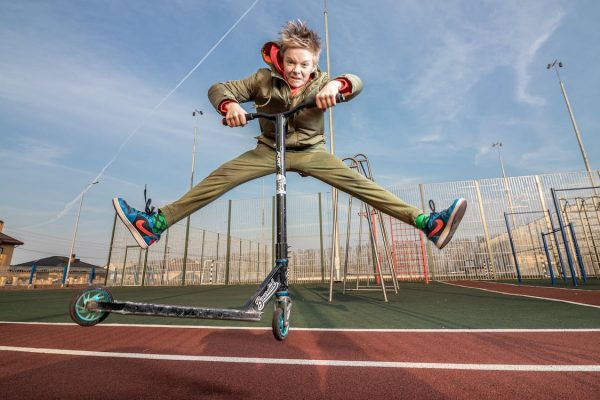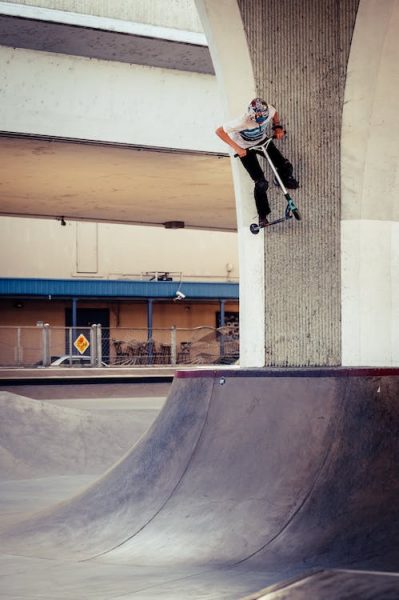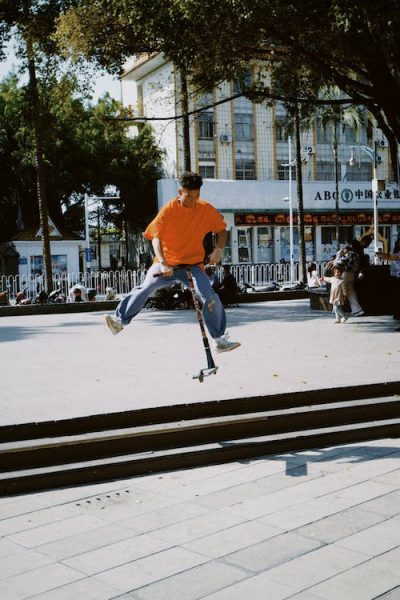As passionate scooter enthusiasts ourselves, we understand the thrill and excitement that comes with mastering new stunts. But let’s be real, the path to becoming a proficient rider isn’t always a smooth ride. It requires dedication, consistency, and most importantly, adopting the right tips.
So if you’re eager to elevate your game, you’ve come to the right place! We’ll guide you through some key advice for scooter tricks, from understanding the basics, warming up and cooling down procedures, mastering basic stunts before moving on to advanced ones, and safety measures to keep in mind throughout this journey. Learning any stunt on a kick scooter, stunt scooter, or trick scooter requires patience and a lot of practice.

There are tons of tricks you can try, such as the bunny hop, tail whip, half cab, wheel lift, nose pivot, tail grab, bar spin, and more. Most of these are done mid-air with the front or rear wheel off the ground. Some of these require a half pipe, but some don’t. If you’re new to riding, you should start with moves for beginners before attempting anything more advanced. Remember, progress is not about speed but consistency, so don’t rush it. Tricks are like fine wine; they get better with time. And at FamilyHype, we want everyone to prioritize safety while practicing.
So buckle up for an adventure on two wheels as we dive into how best to practice those impressive tricks! We encourage you to share your experiences and opinions with us and other readers so that we can all learn from each other and become better scooter riders.
Key Takeaways
We’ll explore the basics of stunts, including warming up and cooling down safely and perfecting simple tricks. Even if it’s challenging, don’t forget to attempt the advanced ones! Consistency is key to progression. With enough time and dedication, you’ll be able to do tricks like a pro!
Before attempting any stunt, it is important to consider safety measures. Make sure you have the right wheels for the trick; for example, if you’re doing a flip, you’ll need a stunt scooter, whereas for a grind, you’ll need a street model. Be sure to wear the proper protective gear, such as a helmet, elbow pads, and knee pads.
Finally, practice in an open area and have someone spot you in case of an emergency. We encourage you to share your progress and experiences with us and your friends and any feedback about this content and your experience. As riders, let us all come together to continue to push our limits and make riding a safe and enjoyable activity for everyone!
Understanding Basic Scooter Tricks
Before we jump into the gnarly tricks, let’s make sure you’ve got the basics down pat for scooters. Maintenance and balance training are vital for safe and effective performance. Keep your scooter in peak condition for safety and performance. You’ll also need to develop your balance to execute tricks flawlessly. With these essential skills mastered, you’re ready for more advanced stunts.
Warm Up And Cool Down
Before we delve into the heart of our training tips, let’s not forget the significance of warming up and cooling down. It’s crucial to stretch thoroughly and engage in basic fitness exercises as riders. These routines help enhance your flexibility, improve your performance, and reduce the risk of injuries while performing tricks.
Importance Of Stretching
The importance of stretching in a practice regimen is clear, as it not only lubricates the joints and warms up the muscles but can also provide injury prevention, performance enhancement, and recovery assistance. When it comes to staying limber, a nutritious diet is essential, while regular stretching can reduce the risk of harm and help with executing stunts smoothly. Plus, stretching speeds healing post-workout.
Next, let’s delve into basic fitness exercises beneficial for riders. These include cardiovascular exercises, strength training, and core exercises. These activities can help riders become more agile and powerful, improve their balance, and boost their endurance. All of these activities are essential components of a well-rounded routine.
Basic Fitness Exercises For Riders
Incorporating basic fitness exercises into your regimen isn’t just about boosting performance on the pavement – it’s also a key way to ensure you’re building strength, agility, and endurance that’ll make every ride more enjoyable. Proper rider nutrition also plays a vital role in fueling these workouts, while equipment maintenance keeps your ride in top shape.
As a rider, incorporating basic exercises like core strengthening, stretching, and weight training into your routine will help you gain an overall better riding experience. Additionally, it’s imperative to understand the importance of maintaining your ride and keeping it in excellent condition. With the right balance of technique, skill, and safety, you can execute basic tricks and stunts that’ll be sure to impress!

Master Basic Tricks
As we delve into mastering the basics, let’s kickstart our journey with two fundamental moves: the Bunny Hop and the Tailwhip. We’ll guide you through these exciting maneuvers, ensuring that you grasp both their technicalities and finesse. You’ll also need to rehearse a smooth landing. Whether it’s achieving lift-off in a Bunny Hop or perfecting that aerial spin in a Tailwhip Trick, we’re here to make sure your scooter trick repertoire is off to an impressive start.
How To Do A Bunny Hop
The bunny hop is a fundamental air trick everyone should know before moving on to more complex moves. We understand the importance of mastering the basics and want to help you perfect your mid-air hop techniques. With our guidance, you’ll soon be showing off your impressive tailwhip skills and joining in the community spirit of scooter lovers!
First, let’s look at the main things we must consider when bunny-hopping on a scooter. This includes the scooter itself, the rider, the terrain, and the hop itself. These components are also affected by other factors, such as the scooter’s weight and size, the rider’s skill level, and the type of terrain.
By understanding the mechanics behind this simple trick, you’ll be able to ride with confidence and finesse. We encourage you to take your time and practice the different hop variations until you’re comfortable. With enough practice, you’ll soon be ready to show off your scooter skills!
How To Do A Tailwhip
Once you’ve nailed the bunny hop, it’s time to take your skills up a notch with the tail whip trick. This easy trick is commonly performed on traditional models, and customization can definitely enhance your ability to perform this trick.
When attempting a tailwhip trick, it’s essential to ensure you have the proper safety gear. While consistent practice is key to mastering this move, patience and persistence will go a long way in perfecting the tailwhip. The trick involves spinning the scooter deck around while airborne and requires a good understanding of balance and momentum.
For those looking to further their skills, mastering the tailwhip is an important milestone.
Advanced Trick Practice
Now that we’ve got the basic stunts under our belt, it’s time to up the ante with some advanced moves. We’re talking about mastering flips and grinds next, two of the most thrilling and visually impressive tricks in scooter riding. Let’s dive into how we can break these advanced skills down into manageable steps for practice and perfection.
Learning How To Do Flips
Mastering flips on your ride isn’t just about showing off your skills; it’s a testament to your determination, patience, and fearlessness. We’ll guide you through flip recovery techniques and fear management strategies to ensure a safe learning experience. Next, we will share some tips on another thrilling aspect of scootering: learning grinds. We’re hoping this article can help riders understand the importance of proper technique, safety, and equipment.
Learning How To Do Grinds
Imagine yourself smoothly gliding your ride along rails and ledges—that’s the thrill of learning grinds! It’s an act of service to oneself, mastering different skateboard and scooter grind variations. Selecting grind rails is crucial; we prefer sturdy, smooth ones for a seamless glide. But remember, technique isn’t everything in this game. Safety should be our main priority as we push our limits.
When it comes to scooters, your main focus should be safety. That means wearing protective gear such as helmets, elbow and knee pads, and wrist guards. Additionally, it’s important to use the appropriate scooter for the intended trick and take necessary precautions like avoiding obstacles or areas with heavy traffic. Let’s get into appropriate safety measures next.
Safety Measures
Before you dive headfirst into those exciting scooter tricks like the tail whip or bar spin, it’s essential to gear up with the right safety equipment. The importance of a helmet can’t be overstated – it safeguards against serious injuries. Selecting the right protective gear is also key to ensuring maximum safety while performing tricky maneuvers on stunt scooters.
We recommend wearing helmets, knee pads, elbow pads, and wrist guards when enjoying the thrill of scooter riding, even during practice. After taking these precautions, we’re ready to delve deeper into the journey of consistent practice and progression in perfecting those exhilarating scooter tricks.

Consistent Practice And Progression
Having covered safety, let’s shift gears to consistent practice and progression! It’s a journey where progress monitoring and goal setting play vital roles in the world of scooters.
Here are some tips to help you reach your goals and progress:
- Set achievable short-term goals. The excitement of reaching them fuels your drive.
- Keep track of your daily progress. It’s rewarding to see how far you’ve come.
- Gradually increase difficulty levels. Overcoming challenges breeds confidence.
Remember, we’re serving not just ourselves but inspiring others too! With the right practice and progression, you can unlock the potential of your scooter and take your skills to the next level.
Conclusion
We’ve explored the basics of stunts, warmed up and cooled down safely, and perfected simple tricks. Consistent practice is key to progression, and we encourage you to keep pushing your limits. Who knows? With enough practice, you’ll be able to do advanced moves like a pro!
Before you start learning stunts, safety measures should always be taken into consideration. Make sure you have the right scooter for the trick. For example, if you’re doing a flip, you’ll need a stunt scooter. For a grind, you’ll need a street scooter. Be sure to wear the proper protective gear, such as a helmet, elbow pads, and knee pads, before hitting the skate park.
Finally, practice in an open area and have someone spot you in case of an emergency. Share your progress and experiences with us and your friends!
Frequently Asked Questions (FAQs):
How Do You Rehearse Stunts On Your Scooter
Practicing scooter tricks involves a lot of patience. Chances are, you’re not going to nail a trick on the first try. But don’t be disheartened. If you keep at it, you’ll be skating like a pro in no time.
What Are The Easiest Stunts To Learn?
Some good scooter tricks for beginners are the bunny hop and the tail whip.
What Is The Hardest Trick On A Scooter?
Some more challenging scooter tricks include the quad barspin, double backflip, quint whip, and backflip tail whip.
How Can I Get Better At Riding A Scooter?
Practice and consistency are the only way to get better at riding a scooter. Incorporate scooter rides into your regular routine to give yourself more chances to practice.
What Is The Proper Posture When Riding A Scooter?
Keep your knees bent while leaning slightly in a forward direction so you don’t lose balance. Your front foot should be your non-dominant foot (for most people, this is the left foot), and your dominant foot should be at the back. Your back should be straight but relaxed.
Is Riding A Scooter Easier Than Riding A Bike?
Most people do say that riding a scooter is easier to learn than riding a bike. A scooter’s riding position is more natural, and the deck is lower to the ground, making it easier to hop on and off.
Are They Good For Exercise?
Yes. Riding a scooter is a great workout. It engages our core muscles, glutes, calves, hamstrings, and more. It also does wonders for our cardiovascular health.
How Do You Ride Confidently?
Like everything else, riding a scooter takes practice. Start by riding in a straight line. Practice accelerating and slowing down by putting pressure and easing up on the back wheel. Then you can start practicing your turns. Remember to keep a firm grip on the handlebar at all times.
How Do You Learn Balance On A Scooter?
Balancing on a scooter has a lot to do with the position of your body while you ride. Make sure that you follow proper scooter posture while you ride, with one foot in front of the other.
What Is The Best Age To Start Riding Scooters?
Many people recommend starting during early childhood since scootering has so many benefits for children. Riding a scooter helps develop motor skills, coordination, balance, and more.
DISCLAIMER (IMPORTANT): This information (including all text, images, audio, or other formats on FamilyHype.com) is not intended to be a substitute for informed professional advice, diagnosis, endorsement or treatment. You should not take any action or avoid taking action without consulting a qualified professional. Always seek the advice of your physician or other qualified health provider with any questions about medical conditions. Do not disregard professional medical advice or delay seeking advice or treatment because of something you have read here a FamilyHype.com.